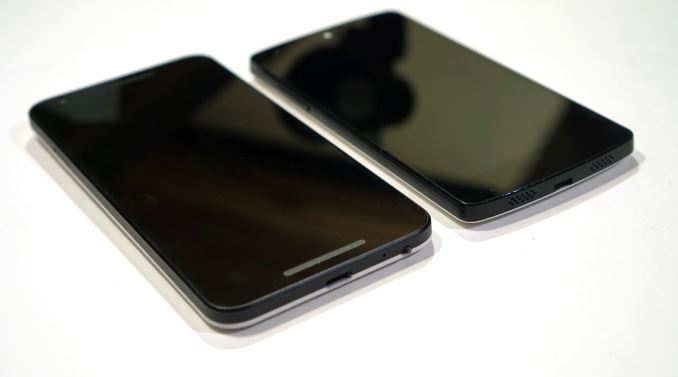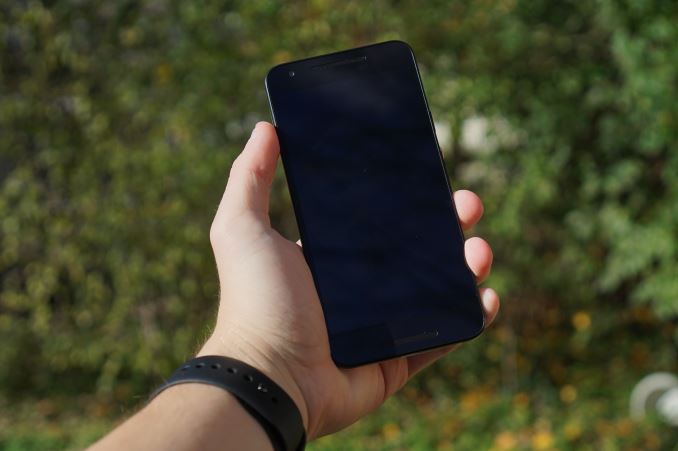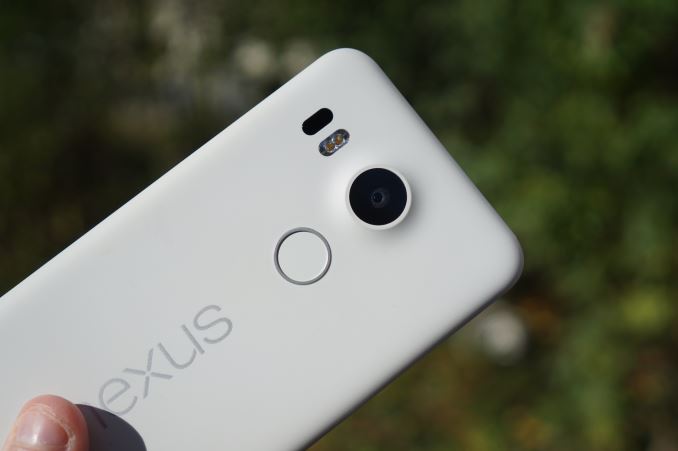The Google Nexus 5X Review
by Brandon Chester on November 9, 2015 8:00 AM EST- Posted in
- Smartphones
- LG
- Mobile
- Android 6.0
- Nexus 5X
Final Words
The Nexus 5X certainly isn't a perfect device. It's not meant to be a flagship phone and it's not priced like one; at $379 it's not the most expensive phone out there, but it's not exactly the cheapest one either. Still, I find myself really liking it despite its flaws. I definitely have a soft spot in my heart for the original Nexus 5, and I was quite disappointed when it didn't receive a true successor last year.
This year's 5X certainly is a true successor, but not every aspect delivers the improvements you would expect from a two year gap between releases. The performance isn't where you'd expect it to be, and Google's stance on disk encryption continues to reduce NAND performance. For all the things the 5X gets wrong though, it gets many other things really right. As always, it's nice to gather everything together in order to decide if a device is worth purchasing.
The design of the 5X is an interesting evolution of the LG Nexus industrial design. It's not as angular as the Nexus 5, but it's still very much a Nexus phone. The design delivered everything I expected from a successor to the Nexus 5, and I like it very much for what it is. The size of the phone is definitely pushing it for me, and I would opt for the size of the Nexus 5 if I had that option, but I also happen to struggle more than most people do with large devices. At $379 there's not much more you can realistically ask for than what the 5X's design and build quality offers.
The 5X's display is awesome, and there's really not much more that needs to be said. The Nexus 5 had a pretty good display for the time, but the 5X definitely takes the calibration and color reproduction to the next level. There's no more messed up low gamma curve, so the display doesn't have the washed out appearance that some people complained about with the Nexus 5's display. Brightness has also been boosted, and contrast is significantly higher too. I really couldn't ask for any more from an IPS LCD panel, and compared to what we got with last year's Nexus 6 the 5X is a breath of fresh air.
Performance is definitely an interesting case. To be frank, the 5X just isn't that much faster in many scenarios than the Nexus 5 was because of the heavy throttling. There's certainly improvement, but it's not what you would expect from two years of SoC progress. Snapdragon 808's heavy throttling means that for any task that taxes the CPU for over a couple of minutes you'd probably be better off with Snapdragon 801, and most certainly better off with 805. It's disappointing, but certainly forgivable when your device costs $379.
As for the GPU performance, Adreno 418 provides a healthy uplift in performance over Adreno 330, and beats Qualcomm's estimates which is great. What's interesting is that the Nexus 6 actually ends up pulling ahead despite being an older phone, which is just the result of how Qualcomm's GPUs were put onto their SoC roadmap. For $379 I think the GPU performance is solid, and there shouldn't be any problems running GPU intensive apps and games from Google Play.
NAND performance is definitely a big area of concern. I don't want to keep beating the issue to death, but Google needs to change their strategy here or they're going to fall very far behind in this regard and there will be no way to catch back up. Devices like the Galaxy S6, and even more so the iPhone 6s have shown how fast NAND speeds can reduce load times, reduce app install times, enable new camera abilities, and do many other things to improve the user experience. The gap between the storage performance of the LG G4 and the Nexus 5X is significant in size despite the two phones using the same NAND solution, and the end result is just completely unacceptable. On top of that, the use of the application processor to perform encryption has an enormous power penalty compared to a dedicated AES engine, which means there are potential battery life improvements just being left on the table.
That said, battery life on the Nexus 5X is quite good, although one should definitely note that the performance the Nexus 5X achieves in tests like BaseMark OS II's battery benchmark is behind that of competing devices that don't use Snapdragon 808 or 810. While it's a bit difficult to weigh these two things, it's essentially a question of whether or not it's worth it for a device to last for a long time when the performance over that period of time wouldn't have provided an enjoyable experience. In the end I think if you need the absolute best performance you're probably not going to opt for a non-flagship phone like the Nexus 5X anyway, and the battery life provided is more than adequate for the average user that will purchase it.
The last major thing to talk about is the camera. This is definitely a home run for Google. After a long period of n-1 cameras, or cameras that were up to par but lacking in processing, we finally get a Nexus device with an awesome camera. Both during the day and at night the quality was better than any of the other devices I used for comparisons, which included the previous two Nexus phones, the Galaxy S6 Edge, and the iPhone 6s. Low light was definitely the biggest victory, although I suspect that the Galaxy Note5 would come closer to the 5X than the S6 Edge does due to the improvements Samsung made to their image processing. In any case, the camera is as good as the flagship devices I've used, which is astonishing for a $379 device. The only drawbacks are the lack of OIS which contributes to shakier video than the previous Nexus phones put out, and the reliance on Google's HDR+ mode to achieve good results which puts a significant delay between shots and could introduce greater blurring in some circumstances. Even with those issues, I really love the Nexus 5X's camera, and it's become my everyday Android phone because of it.
Ultimately, the Nexus 5X is a true successor to the Nexus 5, and for $379 you really can't go wrong when buying one. You're getting a great display, a great camera, a great fingerprint scanner, good battery life, and a chassis that is most definitely plastic, but without any of the flex you see on cheaper devices. For me the camera alone sets the 5X apart from anything else in its price bracket, but pretty much every aspect of it is ahead of the competition at this price point unless you're willing to take a look at imports from Chinese manufacturers, which come with a whole host of other concerns regarding the warranty and network compatibility. The Nexus 5X definitely makes some tradeoffs in order to hit its price target, but if you're looking for a smartphone priced between $300 and $400 I highly recommend you take a look at the Nexus 5X.













197 Comments
View All Comments
Brandon Chester - Tuesday, November 10, 2015 - link
We use iPerf 2 as well, with similar settings but a 60 second test period and only a single thread. 5X is on the latest firmware from Google, and the router is an Archer C7. The phones are always tested right beside the router.I actually tested the Nexus 6 and Galaxy S6 in the exact same configuration to make sure there wasn't some bug, and they achieved the same speeds that we've recorded previously.
Kumar Anand - Tuesday, November 10, 2015 - link
Brandon - Thanks for your reply. This explains the difference. Here is my explanation.With single iperf stream, the CPU utilization is not enough for Nexus 5X and hence due to aggressive power save on Nexus 5X, the CPU clock frequency is likely scaling down impacting the overall Wi-Fi end to end throughput. Hence it is not really the Wi-Fi but the CPU power save that is preventing us from realizing the full capacity of Wi-Fi. Think of this as the classic performance vs power trade off. Nexus 5X has very good battery life due to aggressive power save policy. Other devices might not have as aggressive CPU scaling policy as Nexus 5x and hence do not impact the Wi-Fi TPUT even with the single iperf stream.
If the intention is to see how much (maximum) TPUT Nexus 5X Wi-Fi can handle or achieve, we should pump enough traffic to take the CPU scaling behavior out of the equation. If you run with -P3 iperf option and pump 3 iperf traffic streams, you can realize the full capacity of Wi-Fi throughput. I am able to achieve more than ~600 Mbps consistently with -P3 option.
In summary - the following statement "Nexus 5X's WiFi performance is not very high for a dual spatial stream 802.11ac implementation" is not accurate. A dual spatial stream 11ac chip (like the one in Nexus 5x) can definitely achieve more than ~600 Mbps but you just need to pump enough traffic. I would be very curious to see your revised comparative numbers with -P3 option.
Thank you.
Kumar Anand - Tuesday, November 17, 2015 - link
Hi Brandon - Did you run comparative tests with iperf -P3 option? Are you considering including the revised numbers with -P3 option? For achieving peak performance we should pump 3 streams of iperf traffic. This will really test what is the "max" throughput each of the phones can handle.FL777 - Tuesday, November 10, 2015 - link
Great review. Your phone reviews are the best on the internet with the one exception of your iPhone 6S review where you fall in love with the Apple SoC so much that you start gushing. Yeah the iPhone 6S is the fastest phone on the planet, but it lacks a lot of the sophisticated and very useful features that the Samsung 6S Edge and the Samsung Note 5 have.Google has really stepped up with teh 5x. The 6p is supposed to be a super phone also. I can't wait to see what the Galaxy S7 will look like. It's SoC is supposed to be a beast and the camera is supposed to be the first smartphone camera that rivals dedicated cameras.
Hanknah - Tuesday, November 10, 2015 - link
Do you know of any reason why the Nexus 5x seems to be currently priced at USD $450-550? amazon.com has it from 450-510 and the google store has it from 500-550. I live in Canada so the google store might be showing me Canadian prices but amazon.com is showing the numbers in USD I'm pretty sureRyan Smith - Tuesday, November 10, 2015 - link
The 5X is being sold directly by Google in the US. So Amazon prices would be reseller prices I expect.Goodspike - Tuesday, November 10, 2015 - link
What would be nice is to have test comparisons of new mid-range devices to high end devices from 3-4 years ago. I tried to go back and look at some earlier reviews, but many of the tests have changed (even ones with the same names). But my point is by doing so people would know if they could save money by foregoing something faster than what they have now.evolucion8 - Tuesday, November 10, 2015 - link
I had the Nexus 5 and I wasn't that fond of it, It felt cheaper and less premium compared to the Nexus 4, the camera was horrible when taking pictures and videos, the battery life was disappointing and the SOC would throttle a lot! I returned it and got its brother, the LG G2 and its so much better on every discipline, much better battery life, better screen, much better camera and better build quality. My only grief is that its list of custom ROMs is much smaller compared with what you can get for the Nexus 5, :-(jay401 - Tuesday, November 10, 2015 - link
Does this phone have WiFi Calling?Brandon Chester - Tuesday, November 10, 2015 - link
I actually don't know. Here in Canada we're basically in the dark ages so no carriers have it.